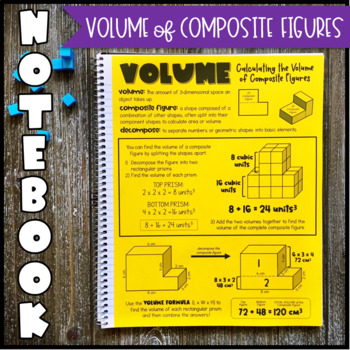Math Notebook: Calculating Volume of Composite Figures (Personal Anchor Chart)
Mrs. Sol
1.9k Followers
Grade Levels
4th - 6th, Adult Education, Homeschool
Subjects
Resource Type
Standards
CCSS5.MD.C.3
CCSS5.MD.C.3a
CCSS5.MD.C.3b
CCSS5.MD.C.4
CCSS5.MD.C.5
Formats Included
- Zip
Pages
1 page
Mrs. Sol
1.9k Followers
What educators are saying
Good resrouce for student math journals. Would love a color version where the two separate shapes within the composite figure are shown with different colors.
Absolutely fantastic resource! My students were fully engaged and excited to participate, which made teaching a breeze. I highly recommend this resource.
Also included in
- This resource includes all of my 5th grade personal anchor charts and more will be added as I create them! These helpful pages will be a welcome addition to fifth grade math notebooks and binders. My students also posted them in their work area at home during remote learning. Parents will appreciatePrice $23.99Original Price $28.00Save $4.01
Description
This personal anchor chart will come in handy as students learn to measure the volume of composite figures. This page will be a helpful addition to fifth grade math notebooks and binders. Parents will appreciate having an explanation of the CCSS standard for homework help and remote learning as well.
Notebook Pages fit:
- 8.5 x 11" spiral notebooks and binders
- smaller notebooks and composition books - printing instructions included
You may also like these notebook pages:
Total Pages
1 page
Answer Key
N/A
Teaching Duration
N/A
Report this resource to TPT
Reported resources will be reviewed by our team. Report this resource to let us know if this resource violates TPT’s content guidelines.
Standards
to see state-specific standards (only available in the US).
CCSS5.MD.C.3
Recognize volume as an attribute of solid figures and understand concepts of volume measurement.
CCSS5.MD.C.3a
A cube with side length 1 unit, called a “unit cube,” is said to have “one cubic unit” of volume, and can be used to measure volume.
CCSS5.MD.C.3b
A solid figure which can be packed without gaps or overlaps using 𝘯 unit cubes is said to have a volume of 𝘯 cubic units.
CCSS5.MD.C.4
Measure volumes by counting unit cubes, using cubic cm, cubic in, cubic ft, and improvised units.
CCSS5.MD.C.5
Relate volume to the operations of multiplication and addition and solve real world and mathematical problems involving volume.





